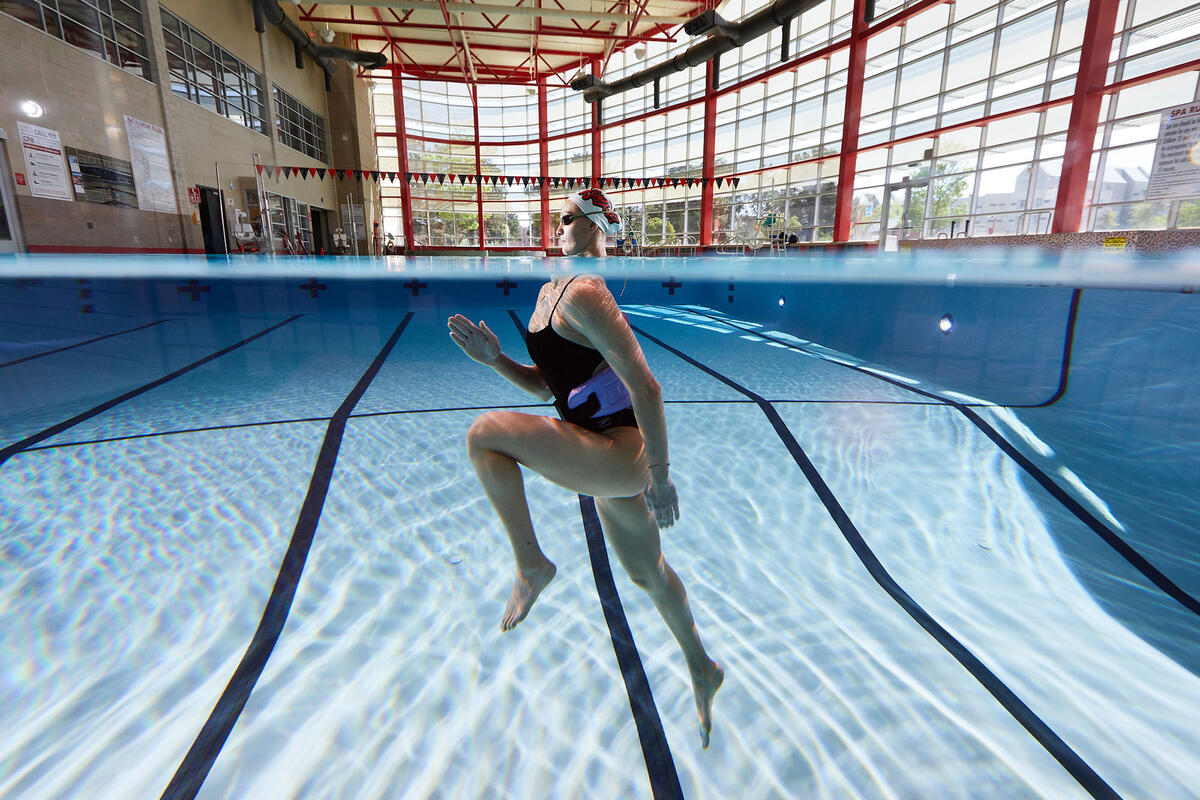There are three types of runners, he likes to say. “You’ve got injured runners,” John Mercer begins, “you’ve got runners recovering from an injury, and you’ve got runners who are about to be injured.”
The kinesiology and nutrition science professor smiles knowingly, his wry grin doubling as a rim-shot. He’s been there — and it’s why he’s here.
Flashback to the late ’80s: Alf was still on prime time, bangs were big enough to imperil low-flying aircraft, and a young John Mercer was working as a lifeguard at Hofstra University in his native New York. A multisport athlete, Mercer was dealing with a knee injury from running at the time (see: above). He saw a guy running in the pool. “I talked with him about what he was doing, and that put me in the direction of running in the water,” Mercer said.
Decades later, he’s devoted a good portion of his academic career to researching the way athletes can perform better in water by improving wetsuit technology, and how they can use water to perform better by studying underwater running for training and rehabilitation.
“In the beginning, the question I was asking was a very theoretical question: Why do we run the way we run? Why do I run the way I run?” Mercer said. “That’s interesting just from a theoretical understanding of movement, but also, how do you help someone run better? How do you help someone run injury free?”

An Iron-Clad Truth
Ask Mercer how many ironman triathlons he’s competed in and he actually has to pause to do the math. “I think I’m at 18,” he notes of the notoriously grueling race, which consists of a 2.4-mile swim, a 112-mile bicycle ride, and a 26.22-mile run. Mercer has competed in triathlons since the mid-’80s, when he first took part in the American Steamship Triathlon in Buffalo. He’s done more than 100 of those since.
His passion for triathlons directly informs his research — and vice versa. “I like to research questions that I want 24 to know the answer to, in this case, why does deep-water running work?” Mercer said. “I asked that question in the early ’90s, and I’m still trying to tease out the exact details 20, 30 years later.”
Mercer came to UNLV in 1999 after earning after his bachelor’s from Buffalo State University of New York, master’s from University of North Texas, and doctorate from the University of Oregon. In 2002, he launched UNLV’s Biomechanics Laboratory with but a few thousand dollars worth of equipment. In the two decades since, Mercer’s frequently collaborated with Kenji Masumoto, an associate professor in the Department of Human Sciences at Japan’s Kyushu University, who did his postdoctoral work at UNLV.
Primarily studying deep-water running, where the feet don’t ever touch the bottom of the pool, they’ve focused on how active muscles are and how they’re being coordinated in this context.
“One of the key messages that we’ve been able to promote is that in order for running in the water to be successful, you need to exercise harder in the water than you do on land,” Mercer said. What he discovered in his research was that by working hard in the water, muscles start to coordinate in a manner similar to on land, without the risk of overuse injury you’d incur on ground. This has practical applications for both rehabilitation and training purposes.
“The other thing I talk with athletes about is that you may be able to supplement your run mileage by adding running in the water versus adding additional miles to a training program,” Mercer said. “Every mile that you add to your training program, you increase the risk of overuse injury. So rather than increase the impact load that you’re experiencing running over ground, add some more time running in the water.”
Equipment Is the Culprit
The deaths were alarming. A little over a decade ago, there was a series of fatalities associated with triathlons “The pattern was that the deaths were occurring in the swim segment,” Mercer said. “That caught my eye because, being in the triathlon world, I was drawn to that. We started looking at the influence a wetsuit would have on blood pressure and then gravitated to core temperature.”
This led to one of Mercer’s grad students doing his thesis on the influence of wearing a wetsuit on blood pressure. “What inspired that study was that it was common advice for triathletes to buy a wetsuit that was tight,” Mercer says. “And the anecdotal advice was, ‘If it doesn’t feel tight, it’s too big.’ What we were able to demonstrate was that too tight of a wetsuit could influence resting blood pressure.”
In addition to his research on running underwater, Mercer has spent much time delving into wetsuit technology, examining ways the garments can be made both safer and more efficient.
“We continue to talk about how a wetsuit can be changed from what it is into what it could be, to be able to get the features that are helpful to performance,” he said, “but then also make it more comfortable because not everyone is trying to go faster in a triathlon — sometimes they just need to be more comfortable, and that’s how they’re going to be faster.”
Mercer entered the world of academia after volunteering for a research study involving cyclists in the late ’80s at Lennox Hill Hospital in New York, becoming fascinated with the process. Thirty-some years later, he’s come full circle. “I got into academics because I participated as a subject,” he says. “Now, I’m conducting the studies, and hoping to inspire someone else when they’re a subject. It’s sort of a neat thing.”
Learn More: The Evidence-Based Triathlete Podcast
Listen to the weekly podcast The Evidence-Based Triathlete with kinesiology professor John Mercer and Tedd Girouard, the program director for UNLV’s athletic training program. The duo discusses the science of triathlons and how to get to the start line injury free.



